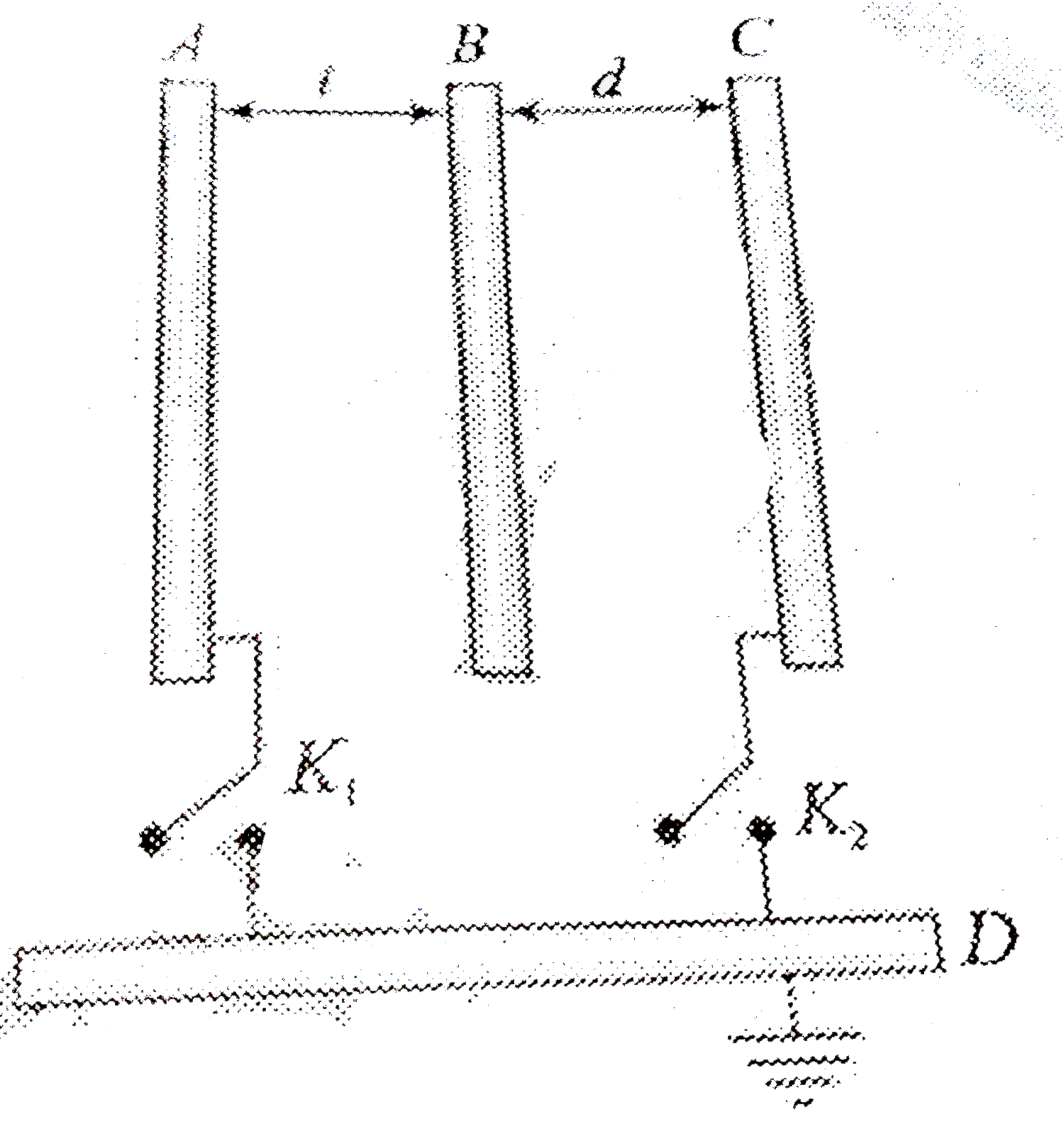Consider two charged metallic spheres S1andS2 of radii 3R and R, respectively. The electric potential V1(onS1)and(onS2) on their surfaces are such that V1V2=41. Then the ratio E1onS1E2(onS2) of the electric fields on their surfaces is:
(a)(54)
(b)(43)
(c)(45)
(d)(34)
The correct Answer is:B
To solve the problem, we need to find the ratio of the electric fields on the surfaces of two charged metallic spheres S1 and S2 given their electric potentials.
1. Understanding the Electric Potential:
The electric potential V on the surface of a charged sphere is given by the formula:
V=kQR
where k is Coulomb's constant, Q is the charge on the sphere, and R is the radius of the sphere.
2. Applying the Formula for Both Spheres:
For sphere S1 with radius 3R:
V1=kQ13R
For sphere S2 with radius R:
V2=kQ2R
3. Setting Up the Ratio of Potentials:
We are given that:
V1V2=41
Substituting the expressions for V1 and V2:
kQ13RkQ2R=41
4. Simplifying the Ratio:
The k and R terms cancel out:
Q13Q2=4
This implies:
Q1=12Q2
5. Finding the Electric Fields:
The electric field E on the surface of a charged sphere is given by:
E=kQR2
For sphere S1:
E1=kQ1(3R)2=kQ19R2
For sphere S2:
E2=kQ2R2
6. Setting Up the Ratio of Electric Fields:
Now we find the ratio of the electric fields:
E1E2=kQ19R2kQ2R2=Q19Q2
The k and R2 terms cancel out.
7. Substituting the Charge Ratio:
We already found that Q1=12Q2:
E1E2=12Q29Q2=129=43
Final Answer:
The ratio of the electric fields on the surfaces of spheres S1 and S2 is:
E1E2=43
The electric potential V on the surface of a charged sphere is given by the formula:
V=kQR
where k is Coulomb's constant, Q is the charge on the sphere, and R is the radius of the sphere.
For sphere S1 with radius 3R:
V1=kQ13R
For sphere S2 with radius R:
V2=kQ2R
We are given that:
V1V2=41
Substituting the expressions for V1 and V2:
kQ13RkQ2R=41
The k and R terms cancel out:
Q13Q2=4
This implies:
Q1=12Q2
The electric field E on the surface of a charged sphere is given by:
E=kQR2
For sphere S1:
E1=kQ1(3R)2=kQ19R2
For sphere S2:
E2=kQ2R2
Now we find the ratio of the electric fields:
E1E2=kQ19R2kQ2R2=Q19Q2
The k and R2 terms cancel out.
We already found that Q1=12Q2:
E1E2=12Q29Q2=129=43
The ratio of the electric fields on the surfaces of spheres S1 and S2 is:
E1E2=43
Topper's Solved these Questions
- JEE MAIN REVISION TEST - 26 (2020)BOOK - VMC MODULES ENGLISHCHAPTER - JEE MAIN REVISION TEST - 26 (2020)EXERCISE - PHYSICS (SECTION 2)
5 Videos
- JEE MAIN REVISION TEST - 25 | JEE - 2020BOOK - VMC MODULES ENGLISHCHAPTER - JEE MAIN REVISION TEST - 25 | JEE - 2020EXERCISE - PHYSICS
25 Videos
- JEE MAIN REVISION TEST - 27 - JEE -2020BOOK - VMC MODULES ENGLISHCHAPTER - JEE MAIN REVISION TEST - 27 - JEE -2020EXERCISE - PHYSICS (SECTION 2)
5 Videos
Similar Questions
Consider two charged metallic spheres S1, and S2, of radii R1, and R2 respectively. The electric fields E1, (on S1,) and E2, (on S2) their surfaces are such that E1/E2=R1/R2. Then the ratio V1(on S1)/V2 (on S2) of the electrostatic potential on each sphere is
View SolutionConsider two charged metallic spheres S1 and S2 of radii R and 4R, respectively. The electric fields E1 (on S1 ) and E2 (on S2) on their surfaces are such that E1E2=51 . Then the ratio V1 (on S1 ) / V1 (on S2 ) of the electrostatic potentials on each sphere is :
View SolutionTwo charged spheres of radii R1andR2 having equal surface charge density. The ratio of their potential is
View SolutionThree plates A, B and C are placed close to each other with +Q charge given to the middle plate. The inner surfaces to A and C can be connected to earth through plate D and keys K1 and K2 . The plates D is a dielectric slab with dielectric constant K1 then the charge that will flow through plate D and keys K1 and K2 . The plate D is a dielectric slab with dielectric constant K, then the charge that will flow though plate D when K2 is closed and K2 is open is

View SolutionS1 and S2 are two equipotential surfaces on which the potentials are not equal
View SolutionTwo metallic s pheres of radii R1 and R2 are connected b y a thin wire. If +q1~and+q_(2) are the charges on the two s pheres then
View SolutionTwo charged metallic spheres of radiir1 and r2 are touched and separated. Calculated the ration of their
(i) Charges
(ii) Potential
(ii) Self energy
(iv) Electric field at the surface
(v) Surface cahrge density
View SolutionIf the sum of n, 2n and infinite terms of G.P. are S1,S2 and S respectively, then prove that S1(S1−S)=S(S1−S2).
View SolutionTwo spheres of radii R1 and R1 respectively are charged and joined by wire. The ratio of electric field of spheres is
View SolutionCharges Q1andQ2 lie inside and outside, respectively, of a closed surface S. Let E be the field at any point on S and ϕ be the flux of E over S.
View Solution
